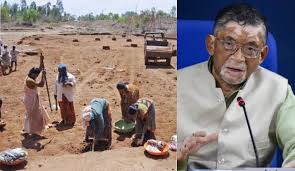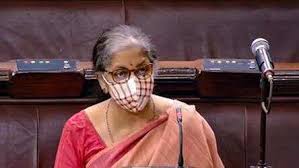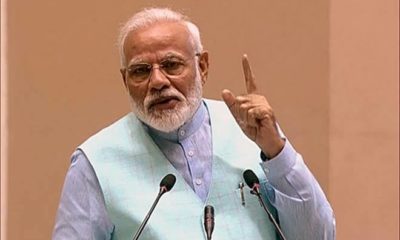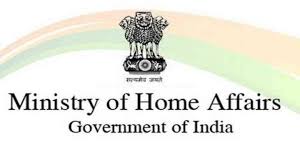Feature
Consolidated Budget Highlights

New Delhi: Highlights of the budget for 2015-16 presented by Finance Minister Arun Jaitley in the Lok Sabha on Saturday:
* Personal income tax rates unchanged
* Increase in limit of deduction in health insurance from Rs.15,000 to Rs.25,000
* For senior citizens, this limit to be increased from Rs.30,000 from present Rs.10,000
* Deduction limit of Rs.60,000 on account of serious diseases to be enhanced to Rs.80,000 for senior citizens
* Exemption on contributions to Pension Fund hiked from Rs.1 lakh to Rs.1.5 lakh per year
* All investment payments in ‘Sukanya Scheme’ will be fully exempted from tax
* Transport allowance exemption raised from Rs.800 to Rs.1,600 per month
* Universal social security system for all Indians, especially poor and disadvantaged sections
* Atal Pension Yojna for economically disadvantaged
* PPF and EPF corpus to be utilised for senior citizens’ welfare fund
* Physical aids and assisting devices for physically challenged senior citizens
* Wealth Tax to be abolished and additional two percent tax on super rich to yield Rs.9,000 crore annually
* GDP growth at 7.4 percent in 2014-15 and at 8-8.5 percent in 2015-16; double-digit growth feasible
* Non-Plan expenditure in 2015-16 estimated at Rs.1,312,200 crore; Plan expenditure estimated at Rs.465,277 crore
* Tax collection in 2015-16 estimated at Rs.1,449,490 crore
* Adequate provision for defence with Rs.246,727 crore earmarked for 2015-16
* Investment on infrastructure to go up by Rs.70,000 crore in 2015-16 over 2014-15
* Education sector allocated Rs.68,968 crore; rural development gets Rs.79,526 crore
* Nirbhaya Fund gets another Rs.1000 crore in 2015-16
* Facilities at eight World Heritage Sites to be restored
* Government to soon launch National Skills Mission
* During 2015-16 AIIMS-like institutes to be set up in Jammu and Kashmir, Punjab, Tamil Nadu, Himachal Pradesh and Aasam ; Bihar to get second AIIMS-like institution
* Karnataka to get an IIT; Indian School of Mines in Dhanbad to be upgraded to IIT
* Fully IT-based student-help facility for needy students
* Corporate tax to be reduced to 25 percent from 30 percent in four years
* Tax exemption for contributions to ‘Swachh Bharat Abhiyan’ and ‘Clean Ganga Fund’ by corporates as part of CSR
* In last nine months several steps taken to effectively deal with problem of black money
* Comprehensive new law to be brought against black money
* Rigorous imprisonment of up to 10 years for concealing income
* Prevention of Money Laundering Act to be amended to provide for forfeiture of property in India if the one abroad cannot be attached
* Law against Benami property in fight against black money
* Quoting PAN essential in property transactions
* Forwards Markets Commission to be Merged with SebiÂ
* Splitting of transaction not to be permitted
* Changes in excise on tobacco items, including cigarettes, paan masala and gutkha
* Excise duty on footwear with leather uppers to be reduced to six percent
* Service tax and education levy to be consolidated from 12.36 percent to 14 percent
* Swachh Bharat cess of two percent, if necessary
* Tax regime to be rationalised
* Applicability of General Avoidance Rules (GAR) to be deferred by two years in view of problems faced in its implementation
* New structure to be put in place in banking sector for seamless integration of data
* Eastern states to be given opportunity to develop faster. Special boost to Bihar and West Bengal as in the case of Andhra Pradesh and Telangana
* Good progress in DMIC corridor and other infra-projects. Rs.1,200 crore earmarked and additional funds if pace of work picks up on ongoing projects
* Procurement law to be drawn up to ensure transparency and remove corruption
* Centenary of Deen Dayal Upadhyay to be celebrated; committee for this to be set up soon
* Good progress being made on Digital India
* To discourage transactions in cash, Rupee debit card to incentivise credit transactions
* In line with ‘Act East Policy’, steps to catalyse investment in this sector through a project development company to oversee investments in Cambodia, Laos and Vietnam
* Tourism has increased after Visa on Arrival introduced for 43 countries. This facility to be increased to 150 countries in different stages
* Public Debt Management Agency to be created to strengthen the bond market
* Gold Monetisation Scheme to be introduced; sovereign gold bonds to be introduced; working on developing Indian gold coin with Ashok Chakra on face
* Vision of making India cashless society
* Foreign Investment in alternative investment funds to be permitted
* Ports in public sector to be encouraged to utilise land under their control
* Make India investment-destination by streamlining permission procedures
* Five ultra-mega power projects each of 4,000 MW to be set up; Second unit of Kudankulam Nuclear Power Station will be commissioned in 2015-16
* Self Employment and Talent Utilisation (SETU) to be Established
* Integrated education and livelihood scheme to be launched
* National investment and infrastructure fund to be launched with corpus of Rs.20,000 crore to generate more funds
* Innovation initiative to be launched in NITI Aayog in the name of former prime minister Atal Bihari Vajpayee
* Government committed to increasing access of people to the banking system
* Postal network across the country to be used for increasing access to formal financial system
* Main challenges: increasing agricultural production; increasing investment in infrastructure; with manufacturing declining, Make in India will create jobs; cooperative federalism
* Agriculture credit targetted at Rs.8.5 lakh crore
* Rural jobs scheme to get Rs.34,699 crore; Allocation to be enhanced by Rs.5,000 crore if additional funds available; Every poor to get a job
* To work with NITI Aayog for creating a National Agricultural Market
* Need well-targeted system for subsidies.
* Direct transfer of subsidy to LPG consumers
* Appeal to well-off consumers to surrender subsidised LPG connections
* Organic farm schemes of agriculture ministry to be supported
* ‘Per drop More crop’ scheme for better irrigation
* Three achievements – Jan Dhan Yojna, coal auctions, Swachh Bharat
* Two more gamechanging reforms: Goods and Services Tax, JAM trinity (Jan Dhan Yojna, Aadhar, Mobile number) to ensure transparency
* Our achievement to conquer inflation, CPI inflation at five percent by year-end
* We are in an economic environment far more positive than in the recent past
* Undertaken several significant steps to energise the Indian economy in last nine months
* India’s chance to fly
* Budget proposals lay down roadmap for economic growth.
* “The Everlasting Flame” exhibition on Parsis to be launched
Entertainment
Meghalaya Reserves Legalized Gambling and Sports Betting for Tourists

The State Scores Extra High on Gaming-Friendly Industry Index
Meghalaya scored 92.85 out of 100 possible points in a Gaming Industry Index and proved to be India’s most gaming-friendly state following its recent profound legislation changes over the field allowing land-based and online gaming, including games of chance, under a licensing regime.
The index by the UK India Business Council (UKIBC) uses a scale of 0 to 100 to measure the level of legalisation on gambling and betting achieved by a state based on the scores over a set of seven different games – lottery, horse racing, betting on sports, poker, rummy, casino and fantasy sports
Starting from February last year, Meghalaya became the third state in India’s northeast to legalise gambling and betting after Sikkim and Nagaland. After consultations with the UKIBC, the state proceeded with the adoption of the Meghalaya Regulation of Gaming Act, 2021 and the nullification of the Meghalaya Prevention of Gambling Act, 1970. Subsequently in December, the Meghalaya Regulation of Gaming Rules, 2021 were notified and came into force.
All for the Tourists
The move to legalise and license various forms of offline and online betting and gambling in Meghalaya is aimed at boosting tourism and creating jobs, and altogether raising taxation revenues for the northeastern state. At the same time, the opportunities to bet and gamble legally will be reserved only for tourists and visitors.
“We came out with a Gaming Act and subsequently framed the Regulation of Gaming Rules, 2021. The government will accordingly issue licenses to operate games of skill and chance, both online and offline,” said James P. K. Sangma, Meghalaya State Law and Taxation Minister speaking in the capital city of Shillong. “But the legalized gambling and gaming will only be for tourists and not residents of Meghalaya,” he continued.
To be allowed to play, tourists and people visiting the state for work or business purposes will have to prove their non-resident status by presenting appropriate documents, in a process similar to a bank KYC (Know Your Customer) procedure.
Meghalaya Reaches Out to a Vast Market
With 140 millions of people in India estimated to bet regularly on sports, and a total of 370 million desi bettors around prominent sporting events, as per data from one of the latest reports by Esse N Videri, Meghalaya is set to reach out and take a piece of a vast market.
Estimates on the financial value of India’s sports betting market, combined across all types of offline channels and online sports and cricket predictions and betting platforms, speak about amounts between $130 and $150 billion (roughly between ₹9.7 and ₹11.5 lakh crore).
Andhra Pradesh, Telangana and Delhi are shown to deliver the highest number of bettors and Meghalaya can count on substantial tourists flow from their betting circles. The sports betting communities of Karnataka, Maharashtra, Uttar Pradesh and Haryana are also not to be underestimated.
Among the sports, cricket is most popular, registering 68 percent of the total bet count analyzed by Esse N Videri. Football takes second position with 11 percent of the bets, followed by betting on FIFA at 7 percent and on eCricket at 5 percent. The last position in the Top 5 of popular sports for betting in India is taken by tennis with 3 percent of the bet count.
Local Citizens will Still have Their Teer Betting
Meghalaya residents will still be permitted to participate in teer betting over arrow-shooting results. Teer is a traditional method of gambling, somewhat similar to a lottery draw, and held under the rules of the Meghalaya Regulation of the Game of Arrow Shooting and the Sale of Teer Tickets Act, 2018.
Teer includes bettors wagering on the number of arrows that reach the target which is placed about 50 meters away from a team of 20 archers positioned in a semicircle.
The archers shoot volleys of arrows at the target for ten minutes, and players place their bets choosing a number between 0 and 99 trying to guess the last two digits of the number of arrows that successfully pierce the target.
If, for example, the number of hits is 256, anyone who has bet on 56 wins an amount eight times bigger than their wager.























